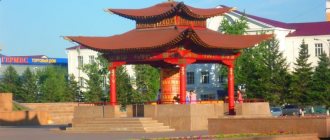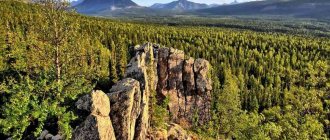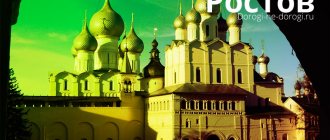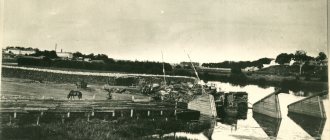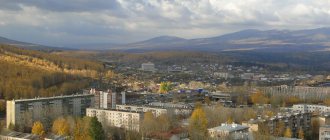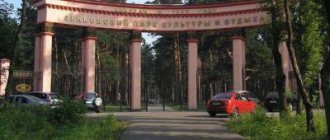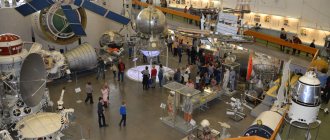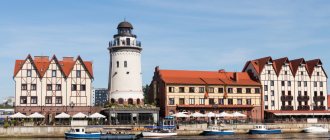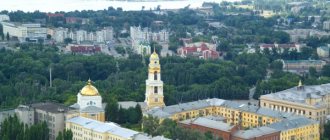Tourism
- Church of Macarius of Altai
- Chuysky tract
- Park "Mount Tuugaya"
- Katun River
- Patmos Island
- Museum of A.V. Anokhin
Western Siberia of Russia is full of beautiful cities, including Gorno-Altaisk. It is located in the very center of Eurasia, surrounded by mountains and forests. Tourists come here to look at nature, walk along cozy streets in search of attractions. If you are planning to someday come to Gorno-Altaisk, then we offer you several places that are worth seeing.
Church of Macarius of Altai
The church appeared in the city only in 2006; now it is considered one of the main religious buildings of Gorno-Altaisk. With its architecture, it is very reminiscent of the Zvenigorod Church of St. Nicholas the Wonderworker , and it was from this that the design of the temple was created.
Church of Macarius of Altai
Unlike most modern churches, the church is built entirely of wood. The building is decorated with log walls, which give the building more coziness. Near the entrance there is a bronze sculpture depicting St. Macarius.
Chuysky tract
This federal road is almost 1000 km long. If you are going to come to Gorno-Altaisk by public or private transport, then you will probably visit the Chuysky tract.
The road is famous for the fact that driving along it, you can endlessly admire the natural landscapes : mountains, rivers, lakes, fields. The tract is beautiful at any time of the year, even in winter. Many tourists do not miss the opportunity to go on a mini-trip to take a lot of spectacular photos.
An interesting fact is that according to National Geographic Russia, the Chuysky tract is one of the most picturesque routes in the world
Description and history of the development of Gorno-Altaisk
Gorno-Altaisk is located in Russia, in the south of Western Siberia. The city is the capital of the Altai Republic. The area of Gorno-Altaisk almost reaches 100 square kilometers, and the number of local residents exceeds sixty-three thousand people. The city stands at the confluence of the Ulalushka and Maima rivers, not far from the Altai Mountains. Local time differs from Moscow by +4 hours.
Altai is translated from the Turkic and Mongolian languages as “gold”, that is, Gorno-Altaisk - “mountain gold”
Gorno-Altaisk is a fairly young city. The first mention of settlements in this place dates back to the beginning of the 19th century - then Teleuts lived in this area. A little later, Russian residents also appeared here and formed the village of Ulala. Also, clergy and merchants settled in the village, thanks to which Ulala began to develop in the commercial sphere. By the end of the 19th century, the village was one of the largest shopping centers in the Tomsk province, which it was part of at that time. After the Revolution of 1917, the village became the center of the newly formed Oirot Autonomous Region, and in 1928 Ulala received city status. Four years later, the settlement was renamed Oirot-Turu, and in 1948 - Gorno-Altaisk. Having received a new name, the city entered a new period: they began to build residential buildings and erect factories. In 1992, Gorno-Altaisk became the capital of the Altai Republic.
Park "Mount Tuugaya"
The height of the mountain is 640 meters, it is located almost in the very center of Gorno-Altaisk. Quite recently, a panoramic park was opened at its top, where guests can visit several observation platforms . They offer stunning views of the city and mountains.
Park "Mount Tuugaya"
The construction of the panoramic park is not yet completely finished. Soon it will be supplemented with shopping and entertainment buildings, cable cars, locations for holidays, etc. Therefore, if you are planning a trip not in the near future, but after 1-2 years, this will only be a plus.
Patmos Island
While traveling along Katun, we recommend visiting the island of Patmos. You can get to it from Gorno-Altaisk in just a couple of hours. The small island is a cliff with a cliff , which can only be reached by crossing a bridge. Patmos, like other places in Altai, surprises with its beauty and panoramas.
The island is interesting not only for its nature, but also for the Temple of St. John the Evangelist standing on it. More than a hundred years ago, the territory of Patmos was consecrated and this structure was erected on it. The temple was robbed several times and attempts were made to destroy it, but each time it was restored. Now there is a convent there, but tourists can also visit it.
You may not know, but there are two islands in the world called Patmos. One is in Altai, and the other is in Greece
Gorno-Altaisk
- Mount Komsomolskaya Pravda and Tugay
Be sure to go to Mount Komsomolka through the forest. It will take a little time, but the views will be excellent. The city will be visible at a glance. After exploring the surroundings of the mountain, move to another mountain - Tugayu. Although it is small, its beauty will surprise you. Not enough impressions? This can be fixed. There are very interesting places within an hour or two hour accessibility. And if you also have your own transport, getting there will be much easier.
- Lake Aya and " Devil's Finger"
Gorno-Altaisk can serve as a starting point for a trip to Lake Aya (translated from Altai as Moon). To get to the lake, you will need to spend about 100 rubles on a bus - the bus ride will take 40 minutes and you will have to walk a little across the bridge. Entrance to the territory of Lake Ai is paid - 150 rubles. After swimming and contemplating the beauty of the lake, you can go to the viewing mountain “Devil’s Finger”. You can also return by bus - just go to the bridge, it’s easier to leave from there. By car you can reach Aya in half an hour.
- "Turquoise Katun" and Tavdinsky (sometimes Taldinsky) caves
Further along the Chuysky tract you will get to the “Turquoise Katun”, it is quite beautiful there, and, moreover, this is the only artificial lake in the Altai Republic. Nearby is the Arzhan Suu silver spring and the Tavdinskie (Taldinskie) caves. From Gorno-Altaisk to these paradises you will have to travel a little longer - about an hour. There are signs everywhere, so you won't get lost. Entrance to the caves costs 100 rubles, for “Turquoise Katun” it will be 250 rubles.
- Kamyshlinsky waterfall
A little further is the Kamyshlinsky waterfall. It is beautiful and popular among tourists, and you can also take a ride to the waterfall on a motorboat or speedboat (it will cost about 300 rubles one way). If you want to walk through the forest and enjoy the views, without extreme sports, then you need to cross the bridge, which is located in the “Royal Hunt” (the passage costs 150 rubles). Let me add that at the Tsarskaya Okhota tourist center you can see a real bear, as well as goldfish swimming in the pond.
If you want to get from Gorno-Altaisk to Zubryatnik or the botanical garden, Chemal, Patmos Island, Lake Manzherok (attractions located more or less close to the city), if you do not have your own transport, it is better to book an excursion. And if you have your own car, you can get to Patmos by driving straight along the Chuysky tract to Ust-Sema, then keep to the left road - the Chemal tract. Lake Manzherok with a chairlift is located along the Chuysky tract after the Turquoise Katun in the village of Ozernoye.
- Botanical Garden and Bison Nursery
The botanical garden is located in the village of Kamlak. To get there, you need to go along the Chuysky tract, in Ust-Sema turn onto the bridge and turn left before Kamlak - there are signs there. A Peruvian Indian lives next to the garden, you can also drop by and visit him. The bison farm is located a little further from Kamlak, before reaching the village of Cherga; after the sign, turn right and you will come across a gate where these animals are actually kept. Bison were brought to Altai from Belovezhskaya Pushcha, they acclimatized and still live, moving away from people in the summer and allowing themselves to be fed in the winter. If you go to a bison farm in the summer, my advice to you is to get together in the evening, around 17:00, by the time you get there, they will go down and you will be able to look at these powerful creatures at a distance of 60-150 m.
Museum of A.V. Anokhin
The institution was opened at the beginning of the last century, its owner was the famous scientist and composer A.V. Anokhin. The museum’s collection includes approximately 66 thousand exhibits that introduce visitors to the life of Gorno-Altaisks of different eras. Among them are labor weapons, books, paintings, costumes, geological exhibits and much more.
Museum of A.V. Anokhin
The most important exhibit of the collection is the mummy of Princess Ukok. Not everyone can see her, since her tomb is opened only on special dates, which depend on Altai traditions.
The listed attractions will leave in your memory only the most pleasant impressions of Gorno-Altaisk. If you have time, we also recommend visiting the Victory Park Memorial Complex, the city cultural park and the Biosphere landscape park.
Historical sites and museums
Museum of Gorno-Altai University
Address: st. Lenina, 1, room 107 Telephone: Opening hours: Mon-Thu 08:00-17:15; Fri 08:00-16:00; Sat-Sun - weekends Cost: free
This is a complex consisting of several divisions dedicated to the history of GASU, archeology, zoology and the nature of the Altai Mountains (it is planned to increase the number of museums in the future).
On the basis of these structures, university students undergo educational practice. The bulk of the exhibits were collected during student expeditions.
In addition to providing scientific and practical information for university students, the museum also hosts quizzes and scientific conferences for schoolchildren, students and teachers from other educational institutions.
Republican Museum of Local Lore named after. V. A. Anokhina
Address: st. Grigory Choros-Gurkina, 46 Phone: 8(3882) 24‑77-73, 8 (3882) 24‑77-70 Website: musey-anohina.ru Opening hours: Wed-Sat 10:00-18:00; Sun 10:00-17:00 Cost: from 50 to 250 rubles
The museum opened on October 29, 1918 on the initiative of the ethnographer and Altai educator Andrei Viktorovich Anokhin. Over the years of its work, the museum has moved twice from different buildings, being located first in the house of the merchant Tobokov, then in the former shop of the merchant Bodunov.
In 1989, a municipal three-story building was built specifically for the needs of the museum, which now houses the largest collection of paintings by the painter Grigory Choros-Gurkin, who depicted Altai landscapes.
In addition to the art gallery, the museum displays archaeological finds discovered in the Altai Mountains, ethnographic maps and other materials illustrating the life and traditions of the Altai peoples from ancient times to the 21st century.
One of the significant museum exhibits is the mummified remains of a female body, found during excavations of one of the ancient burial grounds. The unknown woman was given the name “Princess Ukok”, under which her mummy is kept in the museum’s mausoleum.
Local residents claim that for such inappropriate treatment of her remains, the princess takes revenge on people, periodically sending various natural disasters to the city.
Ulala Paleolithic site
Address: st. Soviet
A protected natural site in the eastern part of the city, on the banks of the Ulalushka River. Here in 1961, a scientific expedition led by archaeologist Alexei Pavlovich Okladnikov discovered traces of the presence of primitive people of the Paleolithic era (about one hundred thousand years BC).
The scientist called this a troglodyte site. Ancient tools made of quartzite were found, images of which appeared later, in 1996, on the coat of arms of Gorno-Altaisk.
The Ulalinskaya site was recognized as the most ancient monument of human activity. However, in the 80s of the 20th century, a version was put forward that those stone figures that scientists perceived as ancient hammers and other tools were simply a consequence of natural changes, that there were no settlements of ancient man in this place. This point of view has not yet received its final confirmation, but it has not been refuted either.
Nowadays, on the site of the Paleolithic site, the Museum of Prehistoric Man has been opened, where his home, household items, weapons, clothes made from animal skins and tools are shown. Museum workers demonstrate the process of making fire by rubbing stones against each other.
They also offer a stylized photo session in animal skins or with Pithecanthropus.

